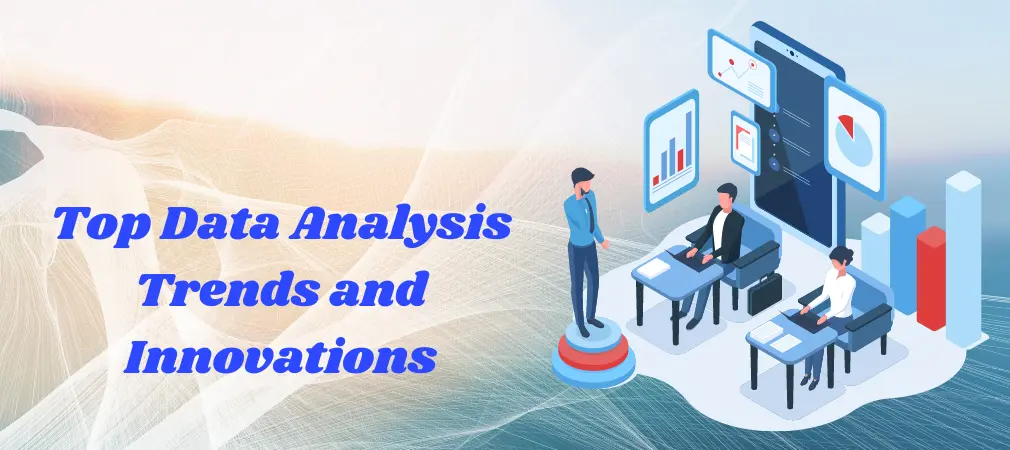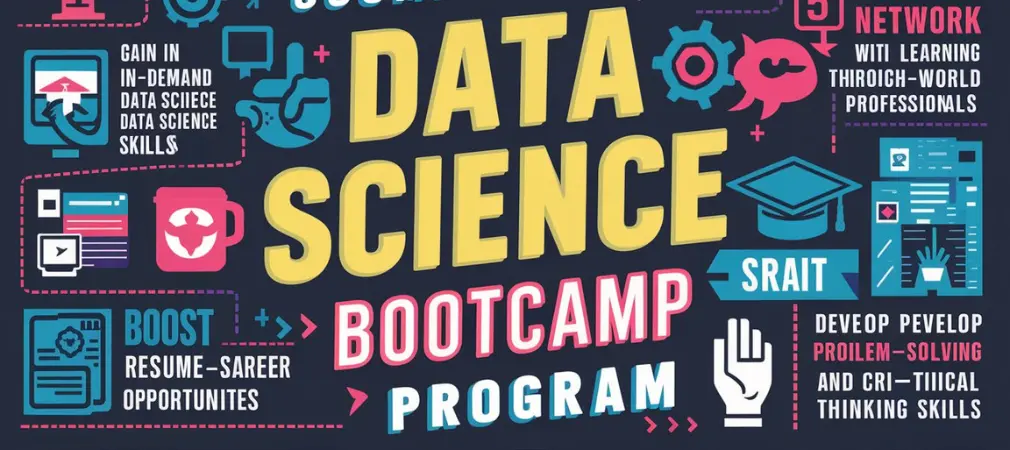Enhance Decision-Making with Data Visualization
Updated on 20th July, 2024
111k views

10 min Read
Introduction
share

The landscape of data analysis is continually evolving, driven by advancements in technology, growing volumes of data, and increasing demand for data-driven decision-making. Staying abreast of the latest trends and innovations in data analysis is crucial for businesses and professionals who want to remain competitive and leverage data for strategic advantage. This article explores the top-notch data analysis trends and innovations that you should follow to enhance your data capabilities and drive success.
1. Artificial Intelligence and Machine Learning
AI-Driven Analytics
Artificial Intelligence (AI) and Machine Learning (ML) have revolutionised data analysis by automating complex processes and enabling predictive and prescriptive analytics. AI-driven analytics platforms can process vast amounts of data quickly and accurately, uncovering patterns and insights that would be difficult for humans to detect.
- Predictive Analytics: Using historical data to predict future outcomes, predictive analytics helps businesses anticipate trends, customer behaviour, and potential risks. Industries like finance, healthcare, and retail are extensively using predictive models to enhance decision-making.
- Prescriptive Analytics: Going beyond prediction, prescriptive analytics suggests actions to achieve desired outcomes. It combines AI, ML, and optimization algorithms to provide recommendations, making it invaluable for strategic planning.
Natural Language Processing
Natural Language Processing (NLP) is a branch of AI that focuses on the interaction between computers and human language. NLP is transforming data analysis by enabling the analysis of unstructured data such as text and speech. - Text Analytics: NLP techniques are used to analyse customer feedback, social media posts, and other text data to extract insights and sentiments. This helps businesses understand customer preferences and improve their products and services.
- Chatbots and Virtual Assistants: NLP-powered chatbots and virtual assistants can interpret and respond to user queries, providing real-time support and data analysis capabilities. This enhances customer service and operational efficiency.
2. Big Data and Real-Time Analytics
Big Data Technologies
Big Data refers to the massive volumes of structured and unstructured data generated every second. To handle and analyse big data, new technologies and frameworks have emerged, making data processing more efficient and scalable.
- Apache Hadoop: An open-source framework that allows for the distributed processing of large data sets across clusters of computers using simple programming models.
- Apache Spark: An open-source unified analytics engine for big data processing, with built-in modules for streaming, SQL, machine learning, and graph processing.
Real-Time Analytics
Real-time analytics involves processing data as soon as it becomes available, enabling immediate insights and actions. This is particularly important for industries where timely decisions are critical, such as finance, healthcare, and e-commerce.
- Stream Processing: Technologies like Apache Kafka and Apache Flink enable the processing of data streams in real-time, allowing businesses to monitor and react to events as they happen.
- Real-Time Dashboards: Interactive dashboards that update in real-time provide an up-to-the-minute view of key performance indicators (KPIs) and metrics, facilitating swift decision-making. regions that need attention.
3. Data Democratisation and Self-Service Analytics
Data Democratisation
Data democratisation aims to make data accessible to everyone within an organisation, regardless of technical expertise. This trend is driven by the need for faster decision-making and the recognition that valuable insights can come from any level of the organisation.
- Data Governance: Effective data governance frameworks ensure that data is accurate, consistent, and secure while being accessible to authorised users. This includes policies, procedures, and tools to manage data quality and compliance.
- Data Literacy: Organisations are investing in training programs to improve data literacy, empowering employees to understand and use data effectively in their roles.
Self-Service Analytics
Self-service analytics tools enable users to perform data analysis and generate reports without relying on IT or data specialists. These tools are designed to be user-friendly, with intuitive interfaces and drag-and-drop functionalities.
- BI Platforms: Business Intelligence (BI) platforms like Tableau, Power BI, and Qlik Sense offer self-service capabilities, allowing users to create their own visualisations and dashboards.
- Data Preparation Tools: Tools like Alteryx and Trifacta simplify data preparation tasks, enabling users to clean, transform, and integrate data without needing advanced technical skills.
4. Cloud Computing and Data Warehousing
Cloud-Based Analytics
- Cloud computing has transformed data analytics by providing scalable, cost-effective, and flexible solutions for data storage and processing. Cloud-based analytics platforms offer numerous benefits, including reduced infrastructure costs, enhanced collaboration, and faster deployment.
- - Scalability: Cloud platforms like AWS, Google Cloud, and Microsoft Azure provide scalable resources that can handle fluctuating data volumes and computational demands.
- - Cost Efficiency: Pay-as-you-go pricing models allow businesses to pay only for the resources they use, reducing the overall cost of data analytics projects.
- Modern Data Warehousing
- Modern data warehouses are optimised for analytical workloads, offering high performance and scalability. They enable businesses to consolidate data from multiple sources into a single repository for comprehensive analysis
-. - Data Lakes: Data lakes store raw, unstructured data in its native format, providing a scalable and flexible solution for big data storage. Technologies like Amazon S3 and Azure Data Lake are popular choices.
- - Data Lake Houses: Combining the best of data lakes and data warehouses, data lake houses provide the scalability and flexibility of data lakes with the structured data management and performance of data warehouses. Databricks and Snowflake are leading platforms in this space.
5. Data Privacy and Security
Data Privacy Regulations
As data breaches and privacy concerns grow, data privacy regulations are becoming more stringent. Regulations like the General Data Protection Regulation (GDPR) in Europe and the California Consumer Privacy Act (CCPA) in the US impose strict requirements on data handling and protection.
- Compliance: Businesses must ensure that their data analytics practices comply with relevant regulations, protecting user privacy and avoiding legal repercussions.
- Data Anonymization: Techniques like data anonymization and pseudonymization are used to protect sensitive information while still allowing for analysis.
Data Security
Protecting data from unauthorised access and cyber threats is critical for maintaining trust and integrity. Data security measures are essential for safeguarding data throughout its lifecycle.
- Encryption: Encrypting data both at rest and in transit ensures that it remains secure, even if intercepted or accessed without authorization.
- Access Controls: Implementing robust access controls and authentication mechanisms ensures that only authorised users can access sensitive data.
6. Augmented Analytics
Augmented analytics leverages AI and ML to automate data preparation, insight generation, and data visualisation, making advanced analytics accessible to a broader audience
- Automated Insights: Augmented analytics platforms can automatically generate insights and recommendations based on the data, reducing the need for manual analysis.
- Natural Language Generation (NLG): NLG technologies enable the generation of human-like text from data, allowing users to receive narrative explanations of their data and insights.
7. Edge Analytics
Edge analytics involves processing data at the edge of the network, closer to where it is generated, rather than in a centralised data centre. This approach is particularly beneficial for applications that require real-time processing and low latency.
- IoT Devices: Edge analytics is widely used in Internet of Things (IoT) applications, where data from sensors and devices needs to be analysed in real-time.
- Reduced Latency: By processing data locally, edge analytics reduces latency and bandwidth usage, improving performance and efficiency.
Conclusion
The field of data analysis is rapidly evolving, with new trends and innovations continuously reshaping how we collect, process, and interpret data. By staying informed about these advancements and incorporating them into your data analytics projects, you can enhance your capabilities, drive better insights, and achieve greater success. Are you ready to take your data analysis projects to the next level? Embrace these top-notch trends and innovations to stay ahead of the curve with Data Analyst Bootcamp Leverage AI and machine learning, harness the power of big data and real-time analytics, democratise data within your organisation, and ensure robust data privacy and security. Invest in modern data warehousing solutions and explore the potential of augmented and edge analytics. Start transforming your data analysis approach today – contact us to learn how we can help you implement these cutting-edge trends and drive your business forward.
Bootcamps
Bestseller
Data Analyst Course
Start Date :Aug 09, 2025
Duration :4 Months
Bestseller
Data Science Course
Start Date :Aug 09, 2025
Duration :4 Months
Suggested Blogs
Top 10 Essential Machine Learning Algorithms for Beginners
Updated on 20th July, 2024

150K views

10 Min read
How Can Data Visualization Enhance Your Data Analytics Projects?
Updated on 20th July, 2024

190k views

10 min Read
Bridging the Gap: The Role of Data Analysts in Empowering Informed Decision-Making
Updated on 21th July, 2024

190k views

10 min Read
More Blogs
© 2025 LEJHRO. All Rights Reserved.





